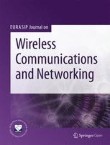The connectivity of the future is envisioned to enable real-time and deterministic networking for seamless integration of the digital world with the biological and physical worlds. A key component of this evolution is the Industrial Internet of Things (IIoT), by enabling a much more pervasive access to data and intelligent control of processes in different vertical applications. Wireless communications for IIoT, build on ultra-reliable and low-latency communications (URLLC) technology, and pose new technology requirements for individual performance indicators such as latency, packet delivery jitter, reliability or achievable throughput, but also regarding the systems dependability, i.e. the ability to make guarantees for deterministic behavior. Current efforts are therefore spent in enabling advanced communication technologies for massive-scale production-line automation and process monitoring for the highly anticipated 4th industrial revolution, Industry 4.0. Especially the fifth generation of mobile communication (5G) is seen as a promising candidate technology for an integrated communication system, which could provide wireless connectivity to the IIoT. Substantial research, development and standardization efforts are then needed in order to design end-to-end (E2E) solutions for next-generation wireless industrial networks. In this regard, largely different industry verticals have joined forces with the telecommunication industry and academia. This includes small and large manufacturers, mining industry, automotive industry, transportation and cargo industry, as well as agriculture, energy and health sectors. The special issue on future wireless access for industrial IoT (FutureIIoT) provide a platform for the timely exchange of research, findings and challenges encountered in building a practical Industrial Internet of Things. It seeks to encourage interdisciplinary discussion in order to help maintain a high relevance in IIoT related research activities.
Topics include, but are not limited to, the following:
- Fundamental trade-offs for reliable communication; Communication protocols for IIoT networks
- Channel measurements and channel modeling in industrial environments
- Potentials and risks of ultra-reliable low-latency communications in unlicensed frequency bands
- Modelling and planning of industrial wireless networks; Wireless communication and control system co-design
- Distributed control and optimization of IIoT systems
- Age of Information
- Tactile Internet
- Enhancements for industrial communication, including architectures for IIoT networks and systems, integration with time-sensitive networks standards, and interworking of public and non-public IIoT networks
- IIoT applications, use cases and quality of service (QoS) frameworks
- Network cybersecurity; physical layer security; jamming prevention, detection and mitigation for industrial wireless control
- Cooperative communication and device-to-device (D2D) relaying for URLLC; multi-connectivity, coordinated multi-point (CoMP) and distributed diversity techniques; distributed space-time and space-frequency diversity
- Advances in multi-antenna systems and MIMO technology for reliable communication
- Communication for unmanned areal vehicles (UAVs), robot fleets, and remote-guided vehicles (RGVs)
- Coexistence of URLLC with enhanced mobile broadband (eMBB) and internet of things (IoT) through scheduling, network slicing
- Potentials and challenges of URLLC in mmWave and terahertz-frequency band
- Exploiting artificial intelligence (AI) and advanced machine learning (ML) techniques in enabling URLLC; Performance prediction and monitoring of IIoT networks
- Ultra-wide band (UWB) communications for high capacity and extreme low latency
- PHY/MAC design for URLLC and mMTC; Waveform design for low latency communication; Advanced channel coding; Optimized low-latency decoders for short packet communication
- Initial and random-access procedures for reliable and real-time access
- Fast and reliable simulation through sampling techniques such as importance sampling and Markov chain Monte Carlo (MCMC)
- Functional safety in IIoT networks
- Experimental verification & technology trial results in industrial scenarios; Proof of concept (PoC) results for URLLC, isochronous networking, and wireless motion control
- Evaluation studies of state-of-the-art factory automation and process automation technologies and standards (such as Wia-Fa, Wia-Pa, IO-Link, WirelessHART, etc.)
Deadline for submissions: 15 April 2021
Lead Guest Editor
Saeed R. Khosravirad, Nokia Bell Labs, USA
Guest Editors
Nikolaos Pappas, Linköping University, Sweden
Wilhelm Keusgen, Fraunhofer Heinrich Hertz Institute, Germany
Holger Claussen, Tyndall National Institute, Ireland
Liang Liu, The Hong Kong Polytechnic University, Hong Kong
Submission Guidelines:
Authors should prepare their manuscript according to the guide for authors available from the online submission page of the EURASIP Journal on Wireless Communications and Networking at https://jwcn-eurasipjournals.springeropen.com/. Authors should select "Advances Industrial Mobile Communications Over Edge Computing: Challenges and Emerging Applications" when they reach the “Article Type” step in the submission process. Submitted papers must contain original work, which has neither been previously published nor it is currently under review by another journal or conference. Previously published or accepted conference papers must contain at least 50% new material to be considered for the special issue.All papers will be peer-reviewed by at least two independent reviewers. Requests for additional information should be addressed to the corresponding guest editor.
Submissions will also benefit from the usual advantages of open access publication:
Rapid publication: Online submission, electronic peer review and production make the process of publishing your article simple and efficient
High visibility and international readership in your field: Open access publication ensures high visibility and maximum exposure for your work - anyone with online access can read your article
No space constraints: Publishing online means unlimited space for figures, extensive data and video footage
Authors retain copyright, licensing the article under a Creative Commons license: articles can be freely redistributed and reused as long as the article is correctly attributed
For editorial inquiries please contact vincent.salvo@springer.com.
Sign up for article alerts to keep updated on articles published in EURASIP Journal on Wireless Communications and Networking - including articles published in this special issue!
